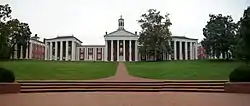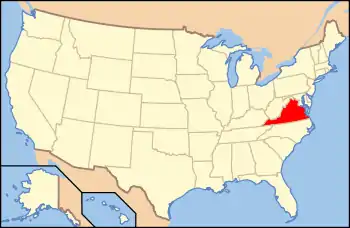Washington and Lee University Historic District
The Washington and Lee University Historic District is a National Historic Landmark District encompassing the historic core elements of the campus of Washington and Lee University in Lexington, Virginia. The campus's Colonnade constitutes one of the nation's finest assemblages of Classical Revival educational buildings, and includes Washington Hall, the school's oldest surviving building. The district also includes Lee Chapel, itself a National Historic Landmark. The district was listed in 1971.[2][3]
Washington and Lee University Historic District | |
 | |
  | |
| Location | Washington and Lee University campus, Lexington, Virginia |
|---|---|
| Coordinates | 37°47′9″N 79°26′39″W |
| Built | 1824 |
| Built by | John Jordan, Samuel Darst |
| Architectural style | Greek Revival |
| NRHP reference No. | 71001047 |
| Significant dates | |
| Added to NRHP | November 11, 1971[1] |
| Designated NHLD | November 11, 1971[2] |
Description and history
Washington and Lee University was founded as Augusta Academy in 1749. Washington Hall, its oldest surviving building, was built in 1824 by John Jordan, a self-taught builder. It is a three-story brick building distinguished by a six-column Doric portico and a cupola topped by a statue of George Washington. Its flanking wings are also fronted by portico styling. This colonnaded Classical style set the tone for later buildings on the campus, including Newcomb Hall and Tucker Hall, which stand on either side. Newcomb, a Late Victorian building, was modified in the 1920s to conform to the Washington Building's style, and Tucker Hall was added in 1935. Flanking the three central buildings are two pairs of faculty residence halls built in 1843, each the four-column Greek Revival porticos.[3]
This row of buildings occupy the top of a roughly north-south ridge. Down the hill to the east stands Lee Chapel, named for Robert E. Lee, who served as Washington College's president and is interred in a crypt within. After Lee's death, the school was renamed Washington and Lee to also honor his role in raising the school's status.[3]
The noted British writer John Cowper Powys once called W&L the "most beautiful college campus in America." The poet and dramatist John Drinkwater remarked, "If this scene were set down in the middle of Europe, the whole continent would flock to see it!"
See also
References
- "National Register Information System". National Register of Historic Places. National Park Service. January 23, 2007.
- "Washington and Lee University Historic District". National Historic Landmark summary listing. National Park Service. Retrieved 2008-04-23.
- Unsigned (n.d.). "National Register of Historic Places Inventory-Nomination: Washington and Lee University Historic District" (pdf). National Park Service. and Accompanying 5 photos, exterior and interior, from 1969 and 1971 (32 KB)
External links
- Washington and Lee University, Lexington, one photo at Virginia DHR
- Historic American Buildings Survey (HABS) No. VA-568-A, "Washington & Lee University, Washington Hall, Jefferson Street, Lexington, Lexington, VA", 4 photos, 8 data pages, 1 photo caption page
- HABS No. VA-568-B, "Washington & Lee University, Lee-Jackson House, 4 University Place, Lexington, Lexington, VA", 2 data pages
- HABS No. VA-568-C, "Washington & Lee University, Lee Chapel, Lexington, Lexington, VA", 10 photos, 10 data pages, 1 photo caption page


